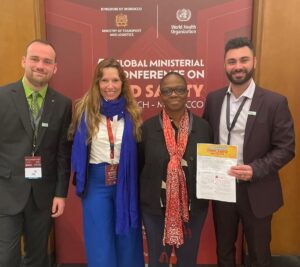
Reflections on the 4th Global Ministerial Conference on Road Safety
This page was last reviewed on April 15, 2025
By Valerie Smith
Director, Road Safety Programs, Parachute and President of CARSP
I work every day driven by Vision Zero road safety principles: to end serious injuries and deaths on our roads. Sometimes, it feels like a goal beyond our grasp. Then there are the days – like the ones I spent at the 4th Global Ministerial Conference on Road Safety, in Marrakesh, Morocco – where I’m inspired by others around the world who bring zeal, and urgency, to our mission.
The conference, held Feb. 18 to 20, 2025, was hosted by the Moroccan government and the World Health Organization. Sadly, recent political developments in the United States meant that no government officials from there attended. However, a strong contingent of Canadians, among them Associate Deputy Minister of Transport Canada, Brigitte Diogo, were among the 5,000 delegates from 193 countries. Diogo was invited to be a speaker in the opening plenary, where she described Transport Canada’s road safety initiatives and also highlighted the important role of civil society in this work.
Prior to the formal start of the conference, some of us had the opportunity to attend two different events. One was the Global Alliance of NGOs for Road Safety symposium. The Alliance does fantastic work to bring together NGOs and road safety associations from countries around the world. They provide the backbone holding us together so we can engage as a global movement with the Decade of Action for Road Safety, 2021-2030, and also advocate for change in our own countries.
At the same time as the Alliance Symposium was a World Youth Congress, which engaged young leaders in the development of the Global Youth Statement for Road Safety, a bold call to action demanding safer, more sustainable mobility worldwide. Parachute and CARSP supported two Canadian youth delegates, who are Parachute youth ambassadors, Robert Colonna from Ontario and Jerome Range from Québec, to attend and participate.
The actual Ministerial Conference had a number of excellent plenary and breakout sessions focused on topics such as government accountability and commitment; the intersections of road safety with climate change, sustainable transport; emerging mobility trends; sustainable road safety funding; and many more. From my perspective, it was a great opportunity to learn about the global efforts: successes and challenges of other countries around the world. At times, I felt more like I was attending a rock concert than a road safety symposium: both the production values, and the crowd enthusiasm, had that kind of scale.
Within the grandeur were the quiet moments where we made important connections to support our work promoting road safety. I was grateful to facilitate a meeting and discussion between Associate Deputy Minister Diogo and our two youth delegates in a tucked-away conference site corner.
The conference wrapped up with The Marrakech Declaration with 27 articles and seven pages of text; Article No. 2 (No. 1 being a thank you to the King of Morocco) calls on all governments to implement all recommendations set out in the Global Plan for the Decade of Action for Road Safety 2021-2030.
While the Morocco gathering was an excellent and inspiring conference, there is still substantial work to be done around the world. While globally there has been a reduction of five per cent in the number of deaths between 2010 and 2021 (the first global decade), the overall target of a 50-per-cent reduction of global deaths and injuries from road traffic crashes was not achieved by 2020 and has a long way to go to be achieved by 2030.
Despite, the slow progress, 35 member states have achieved reductions of 30-to-49 per cent in the number of deaths due to road traffic crashes and 10 member states have reached the 50-per-cent target reduction in road traffic deaths. On my to-do list is examining those countries’ strategies and tactics that have led to these live-saving results.
What about the future? A month after the conference, the Global Alliance issued a news release analyzing declarations about commitments to improved road safety, and reduced deaths, made during the conference, in line with the commitments of the Global Decade of Action. This analysis found that “only 25 out of 194 WHO member states made a public commitment during the plenary sessions … The low uptake by heads of delegations to publicly make commitments falls short of the universal commitment needed to halve road deaths and injuries by 2030.” The analysis also revealed cautious and passive language in forms of encouragement and acknowledgements without guarantees of delivery – ‘express deep concern’, ‘recognize’, ‘consider’, ‘encourage’. There was also an inadequate focus on evidence-based interventions in the public commitments with only “five out of 25 countries (20%) mentioned using a Safe System Approach, while 3 countries (12%) mentioned Vision Zero.”
So, yes, we are not moving fast enough. We are halfway through the Global Decade of Action for Road Safety, 2021-2030, and we have significant more work to do to meet the international goals we committed to. But we are moving in the right direction. We have allies across the globe. And if the passion I saw among the youth delegates is any indication, my generation of road safety advocates have an amazing next wave at our heels who will be relentless in working to reduce road-injury deaths across the globe.